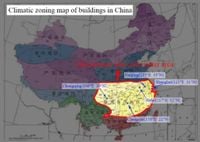As the elderly population grows rapidly in China, the design and renovation of senior living communities are becoming critical areas of study. A recent study published in Nature Scientific Reports explores energy efficiency in these communities by analyzing building load characteristics in five Chinese cities known for their hot summers and cold winters. The study investigates how different wall insulation thicknesses and window glazing types impact annual heating and cooling loads.
The research was motivated by the rapid increase of seniors within the population, which more than doubled in just a few decades. With a considerable proportion of older adults requiring care and comfort, optimizing their living environments becomes paramount. Seniors, who spend nearly all their time indoors, have specific thermal comfort needs that differ from younger individuals.
In the study, simulation models were employed to calculate annual cooling and heating loads, wherein results indicated that annual cooling loads varied significantly from 113.0 W/m² to 145.7 W/m², while heating loads ranged between 14.7 W/m² and 41.8 W/m² across the studied regions. The researchers noted that Chongqing benefits the most from a configuration of single-glazed windows combined with a 0.06 m insulation layer, making it the most efficient option for that locality.
For other cities, different configurations yield the best results: Changsha, Hefei, Nanjing, and Shanghai all showed optimal performance with double-glazed windows, along with insulation layers of 0.08 m, 0.10 m, 0.10 m, and 0.06 m respectively. Notably, Shanghai stands out with the lowest life cycle cost, approximately 30% less than the other cities due to its reduced cooling load during summer.
The minimum life cycle costs for upgrading air conditioning and enclosure structures in these senior living communities ranged from 148,000 RMB to 165,000 RMB, indicating a comprehensive financial assessment that considers both the initial investment and long-term operational costs. The implemented life cycle cost analysis not only serves to guide construction and renovation efforts but also addresses energy efficiency, thus aligning these improvements with China's goal of peaking carbon emissions by 2030 and achieving carbon neutrality by 2060.
As government policies push for sustainability and energy conservation, the implications of this research extend beyond mere cost considerations. By tailoring building designs to the specific thermal comfort requirements of the elderly population, this approach highlights the intersection of energy efficiency and social responsibility.
The methodological framework of the study relied on the yearly simulation of cooling and heating loads, which contributes valuable insights into how buildings can be optimized to meet both environmental standards and residents' comfort needs. By applying principles of energy-saving design, the study significantly enhances the understanding of how envelope parameters like thermal insulation and window type can alleviate energy consumption issues common in senior living communities.
This analysis adds a crucial dimension to the broader conversation surrounding aging populations and how society can adapt to meet their needs. Given that over 80% of a senior’s time is spent indoors, ensuring thermal comfort through improved building designs becomes essential.
The study concludes with recommendations for design optimizations specific to each city, ultimately serving the dual purpose of reducing energy demands while improving residents’ comfort levels. Chongqing's preference for single-glazed windows with thinner insulation contrasts with the thicker insulation and double-glazing recommended for cities like Hefei and Nanjing.
With growing attention on energy-efficient buildings amid increasing environmental concerns, this research serves as a timely reminder of the importance of science in tackling the pressing challenges faced by an aging population. Future studies might build on these findings by exploring additional insulation materials or advanced glazing technologies to further enhance the sustainability of senior living environments.

